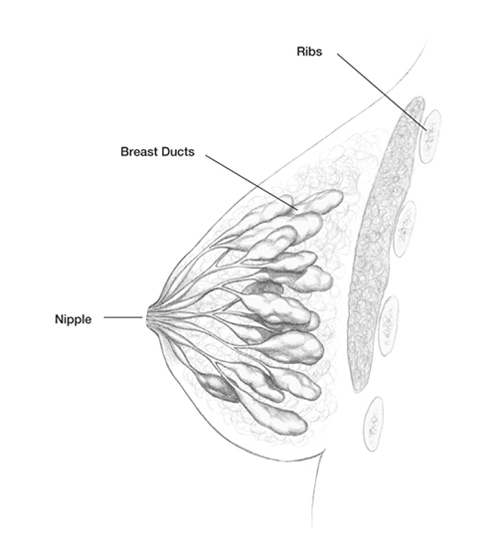4. Stretch Marks
Many women have stretch marks, called striae distensae,
during pregnancy. They occur when the elastic fibers and collagen in
deeper layers of your skin are pulled apart to make room for baby. When
skin tears, collagen breaks down and shows through the top layer of your
skin as a pink, red or purple indented streak.
Nearly 9 out of 10 pregnant women develop
stretch marks on their breasts, tummy, hips, buttocks and/or arms. They
may appear any time during pregnancy. After birth, they may fade to the
same color as the rest of your skin, but they won’t go away.
You can help yourself by gaining weight slowly and steadily during pregnancy. Any large increase in weight can cause stretch marks to appear more readily.
Drink lots of water, and eat healthy
foods. Foods high in antioxidants provide nutrients you need to repair
and heal tissue. Eating enough protein and smaller amounts of “good”
fats, such as flaxseed, flaxseed oil and fish oils, may also help you.
Although you’d like to think you can keep
stretch marks from happening to you, there really isn’t much you can do
to prevent them. Creams and lotions you see advertised on TV and in
magazines don’t really work. You’ll get stretch marks if you’re going to
get them (some lucky women get very few, if any!). They’re just a part
of being pregnant.
Stay out of the sun! Keep up with your exercise program.
Ask your healthcare provider about using
creams with alpha-hydroxy acid, citric acid or lactic acid. Some of
these creams and lotions improve the quality of the skin’s elastic
fibers.
Don’t use steroid creams, such as
hydrocortisone or topicort, to treat stretch marks during pregnancy
without first checking with your healthcare provider. You absorb some of
the steroid into your system, and the steroid can pass to baby. And
stretch creams really can’t penetrate deeply enough to repair damage to
your skin.
Treatment after Pregnancy.
After pregnancy, you have quite a few treatment options. Some
treatments hold promise. If you’re left with lots of stretch marks, you
may want to ask about prescription creams, such as Retin-A or Renova, or
laser treatments.
Retin-A, in combination with glycolic
acid, has been shown to be fairly effective. Prescriptions are needed
for Retin-A and Renova; you can get glycolic acid from your
dermatologist. Cellex-C, with glycolic acid, also helps with stretch
marks.
The most effective treatment is laser
treatment, but it can be costly. It’s often done in combination with the
medication methods described above. However, lasers don’t work for
everyone.
Massage may help—it
increases blood flow to the area, which helps gets rid of dead surface
cells. Discuss treatment with your healthcare provider if stretch marks
bother you after pregnancy.
5. Changes in Your Breasts
Your breasts are changing. The mammary gland (another name for the breast) got its name from the Latin term for breast—mamma.
Before pregnancy, your breasts may weigh
about 7 ounces (200g) each. During pregnancy, they increase in size and
weight as you add fat in your breast tissue. Near the end of pregnancy,
each breast may weigh 14 to 28 ounces (400 to 800g). During nursing,
each breast can weigh 28 ounces (800g) or more.
A breast is made up of glands, tissue to
provide support and fatty tissue for protection. Each nipple contains
nerve endings, muscle fibers, sebaceous glands, sweat glands and about
20 milk ducts. Milk-producing sacs connect with the ducts leading to the
nipple.
Grandma’s Remedy
If you want to avoid using medication,
try a folk remedy. If you get a paper cut, apply some lip balm to help
heal the cut and reduce skin irritation.
From the beginning of pregnancy, your body
is getting ready to breastfeed. Soon after pregnancy begins, the
alveoli begin to increase in number and to grow larger. Milk sinuses,
located close to the nipple, begin forming; they hold the milk you will
produce. By as early as 20 weeks of pregnancy, your breasts will begin
to produce milk. Even if you give birth weeks earlier than your due
date, your breast milk will be nutritious enough to nourish a premature
baby.
You may notice veins appearing just
beneath the skin and a change in nipples. They may get larger and more
sensitive. The nipple is surrounded by the areola, a circular, pigmented
area. During pregnancy, the areola darkens and grows larger. A darkened
areola may act as a visual signal to baby. Bumps on your nipples,
called Montgomery glands, secrete fluid to lubricate and protect your nipples if you breastfeed.

Development of the maternal breast by the end of
the first trimester (13 weeks of pregnancy).
During the second trimester, a thin yellow fluid called colostrum
begins to form. It can sometimes be pressed from the nipple by gentle
massage. You may also notice stretch marks on your breasts. During the
third trimester, your breasts may itch as skin is stretched. An
alcohol-free, perfume-free moisturizer may help. Your breasts will reach
their maximum size a few days after baby’s birth.